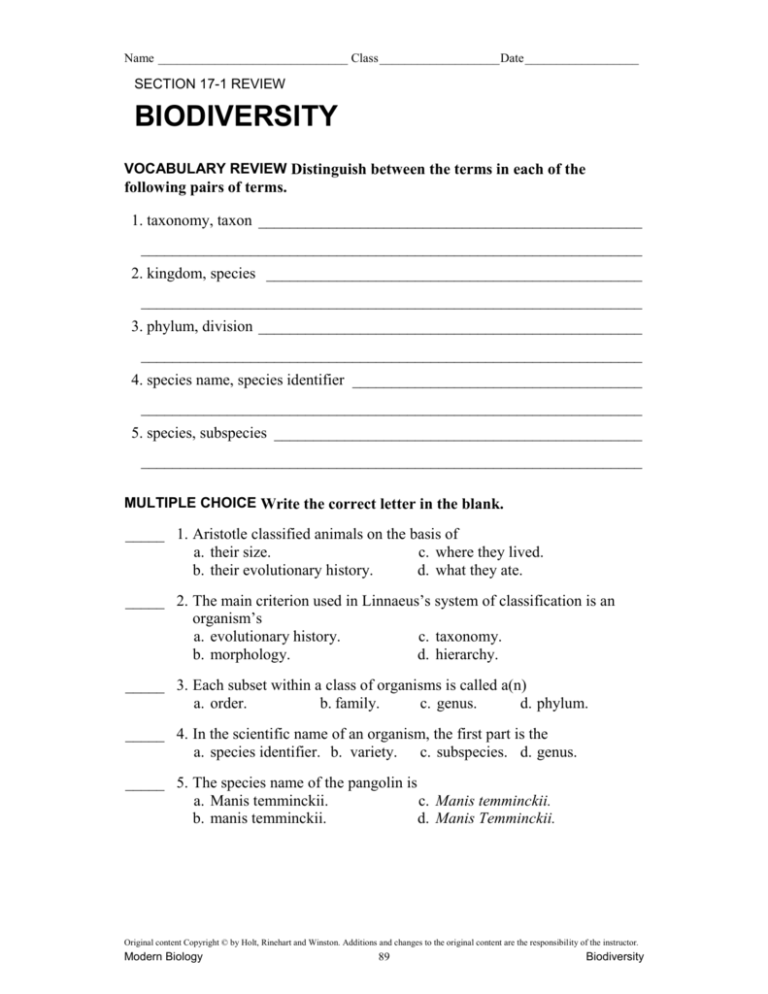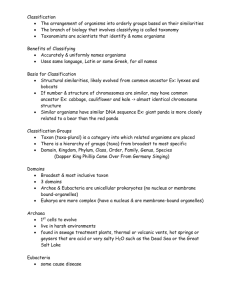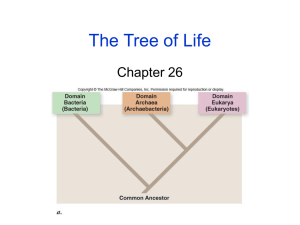Biodiversity Worksheet: Taxonomy & Systematics Review
advertisement

Name ______________________________ Class ___________________ Date __________________ SECTION 17-1 REVIEW BIODIVERSITY VOCABULARY REVIEW Distinguish between the terms in each of the following pairs of terms. 1. taxonomy, taxon _________________________________________________ ________________________________________________________________ 2. kingdom, species ________________________________________________ ________________________________________________________________ 3. phylum, division _________________________________________________ ________________________________________________________________ 4. species name, species identifier _____________________________________ ________________________________________________________________ 5. species, subspecies _______________________________________________ ________________________________________________________________ MULTIPLE CHOICE Write the correct letter in the blank. _____ 1. Aristotle classified animals on the basis of a. their size. c. where they lived. b. their evolutionary history. d. what they ate. _____ 2. The main criterion used in Linnaeus’s system of classification is an organism’s a. evolutionary history. c. taxonomy. b. morphology. d. hierarchy. _____ 3. Each subset within a class of organisms is called a(n) a. order. b. family. c. genus. d. phylum. _____ 4. In the scientific name of an organism, the first part is the a. species identifier. b. variety. c. subspecies. d. genus. _____ 5. The species name of the pangolin is a. Manis temminckii. c. Manis temminckii. b. manis temminckii. d. Manis Temminckii. Original content Copyright © by Holt, Rinehart and Winston. Additions and changes to the original content are the responsibility of the instructor. Modern Biology 89 Biodiversity Name ______________________________ Class ___________________ Date __________________ SHORT ANSWER Answer the questions in the space provided. 1. How were the classification systems of Aristotle and Linnaeus similar? _____ ________________________________________________________________ ________________________________________________________________ 2. The word part bi- means “two,” and the word part nomen means “name.” Explain how these word parts relate to the system scientists use to identify organisms. ______________________________________________________ ________________________________________________________________ 3. How does the classification process used by modern taxonomists differ from that used by Linnaeus? ________________________________________________________________ ________________________________________________________________ 4. Critical Thinking Explain why Aristotle’s system of classifying animals is no longer used by biologists. Use examples from the animal kingdom to support your answer. ____________________________________________________ ________________________________________________________________ ________________________________________________________________ ________________________________________________________________ STRUCTURES AND FUNCTIONS Use the figure to fill in the names of the seven levels of organization in the modern Linnaean system of classifying organisms, with a representing the smallest category and h the largest category. Original content Copyright © by Holt, Rinehart and Winston. Additions and changes to the original content are the responsibility of the instructor. Modern Biology 90 Biodiversity Name ______________________________ Class ___________________ Date __________________ SECTION 17-2 REVIEW SYSTEMATICS VOCABULARY REVIEW Define the following terms. 1. systematics _____________________________________________________ ________________________________________________________________ 2. phylogenetic diagram _____________________________________________ ________________________________________________________________ 3. cladistics _______________________________________________________ ________________________________________________________________ MULTIPLE CHOICE Write the correct letter in the blank. _____ 1. The scales of snakes and the scales of pangolins a. are shared derived characters. c. suggest descent from a common ancestor. b. are homologous structures. d. evolved independently in the two groups. _____ 2. In cladistics, what term is used for a group of organisms that includes an ancestor and all of its descendants? a. class c. phylum b. clade d. species _____ 3. The molecular-clock model of evolutionary relationships is based on the assumption that changes in macromolecule sequences a. are not random. b. are affected by natural selection. c. are greater in species with more-distant common ancestors. d. occur at different rates in different organisms. _____ 4. One example of a derived character is provided by the a. feathers of birds. c. scales of pangolins. b. scales of snakes. d. chromosomes of chimpanzees. _____ 5. Which of the following do cladistic taxonomists NOT compare when hypothesizing evolutionary relationships among organisms? a. morphological similarities c. homologous chromosomes b. analogous structures d. shared derived characters Original content Copyright © by Holt, Rinehart and Winston. Additions and changes to the original content are the responsibility of the instructor. Modern Biology 91 Biodiversity Name ______________________________ Class ___________________ Date __________________ SHORT ANSWER Answer the questions in the space provided. 1. List three types of evidence used by systematic taxonomists to construct phylogenetic diagrams. ________________________________________________________________ ________________________________________________________________ ________________________________________________________________ 2. What is an out-group in cladistic analysis? _____________________________ ________________________________________________________________ ________________________________________________________________ ________________________________________________________________ 3. How do derived characters help cladistic taxonomists determine phylogenetic relationships? ________________________________________________________________ ________________________________________________________________ ________________________________________________________________ 4. Critical Thinking A paleontologist studying two modern species finds a 7million-year-old fossil organism with a morphology similar to the modern species and concludes that it is an ancestor of both. A molecular biologist studying the amino acid sequence of a particular protein in both modern species concludes that the two species last shared a common ancestor 12.5 million years ago. Suggest possible reasons for the discrepancy in the two conclusions. ________________________________________________________________ ________________________________________________________________ ________________________________________________________________ STRUCTURES AND FUNCTIONS Use the figure to answer the following questions. The phylogenetic diagram shown below indicates the evolutionary relationships for a hypothetical group of modern organisms, labeled 1–5, and their ancestors, labeled A–G. 1. Which two modern organisms are likely to be most closely related? __________________ 2. What was the most recent common ancestor of organisms 2 and 3? ____________________ 3. What was the most recent common ancestor of organisms 1 and 5? ____________________ Original content Copyright © by Holt, Rinehart and Winston. Additions and changes to the original content are the responsibility of the instructor. Modern Biology 92 Biodiversity Name ______________________________ Class ___________________ Date __________________ SECTION 17-3 REVIEW MODERN CLASSIFICATION VOCABULARY REVIEW For each of the kingdoms listed below, state the cell type (prokaryotic or eukaryotic), number of cells (unicellular, multicellular, or both), and form of nutrition (autotrophy, heterotrophy, or both). 1. Archaebacteria __________________________________________________ 2. Eubacteria ______________________________________________________ 3. Protista ________________________________________________________ 4. Fungi __________________________________________________________ 5. Plantae ________________________________________________________ 6. Animalia _______________________________________________________ MULTIPLE CHOICE Write the correct letter in the blank. _____ 1. The organisms that live in hostile environments that cannot support other forms of life are members of the domain a. Bacteria. b. Archaea. c. Eukarya. d. None of the above _____ 2. Amoebas and paramecia belong to the kingdom a. Fungi. b. Plantae. c. Protista. d. Archaea. _____ 3. Mushrooms, puffballs, mildews, and some molds belong to the kingdom a. Fungi. b. Plantae. c. Protista. d. Eukarya. _____ 4. The domain that includes the oldest known fossil cells is called a. Eukarya. b. Archaea. c. Bacteria. d. Eubacteria. _____ 5. The domain that includes organisms with true nuclei and membranebound organelles is called a. Bacteria. b. Archaea. c. Animalia. d. Eukarya. _____ 6. The domain Eukarya includes a. archaea, protists, fungi, and plants. b. protists, fungi, plants, and animals. c. protists, fungi, eubacteria, and archaea. d. fungi, eubacteria, plants, and animals. Original content Copyright © by Holt, Rinehart and Winston. Additions and changes to the original content are the responsibility of the instructor. Modern Biology 93 Biodiversity Name ______________________________ Class ___________________ Date __________________ SHORT ANSWER Answer the questions in the space provided. 1. What characteristics distinguish archaea from bacteria? __________________ ________________________________________________________________ ________________________________________________________________ 2. What characteristics distinguish fungi from plants? _____________________ ________________________________________________________________ ________________________________________________________________ 3. Which kingdoms include multicellular heterotrophic organisms? ___________ ________________________________________________________________ 4. What evidence led scientists to develop the three-domain system of classification? ___________________________________________________ ________________________________________________________________ ________________________________________________________________ 5. Critical Thinking Another possible way to classify organisms would be to separate them into unicellular and multicellular organisms. Explain why this is not a useful classification system. ________________________________________________________________ ________________________________________________________________ ________________________________________________________________ ________________________________________________________________ STRUCTURES AND FUNCTIONS The diagram below represents the relationship between the three-domain system and the six-kingdom system of classifying organisms. Label each box in the diagram with the correct domain or kingdom name. Original content Copyright © by Holt, Rinehart and Winston. Additions and changes to the original content are the responsibility of the instructor. Modern Biology 94 Biodiversity








